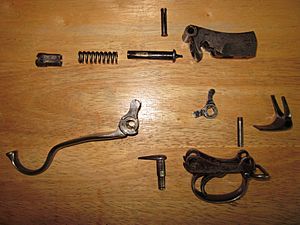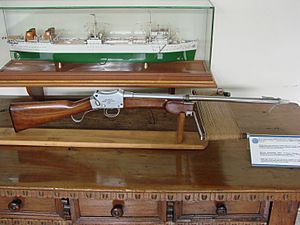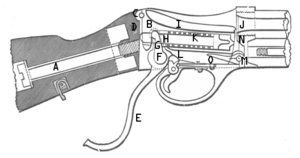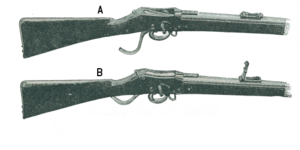Martini–Henry facts for kids
Quick facts for kids Martini–Henry Mk I–IV |
|
|---|---|
 |
|
| Type | Service rifle Shotgun (Greener Prison Variant) |
| Place of origin | United Kingdom |
| Service history | |
| In service | 1871–1918 |
| Used by | See Users |
| Wars | British colonial wars Perak War Second Anglo-Afghan War Argentine Civil Wars Herzegovina Uprising (1875–1878) Russo-Turkish War War of the Pacific Anglo-Zulu War First Italo-Ethiopian War North-West Rebellion Greco-Turkish War (1897) First Boer War Second Boer War Balkan Wars World War I Greco-Turkish War (1919–22) The Troubles War in Afghanistan (1978–present)(limited) |
| Production history | |
| Designer | Friedrich von Martini |
| Designed | 1870 |
| Manufacturer | Various |
| Unit cost | ~£2/2/–=£2.10 (late 1880s) |
| Produced | 1871–1889 |
| No. built | approx. 500,000–1,000,000 |
| Variants | Martini–Henry Carbine Greener Prison Shotgun Gahendra rifle |
| Specifications | |
| Mass | 8 pounds 7 ounces (3.83 kg) (unloaded), 9 pounds 4.75 ounces (4.22 kg) (with sword bayonet) |
| Length | 49 inches (1,245 mm) |
| Barrel length | 33.22 inches (844 mm) |
|
|
|
| Cartridge | .577/450 Boxer-Henry .577/450 Martini–Henry .303 British 11.43×55R (Ottoman) 11.43×59R (Romanian) 7.65×53 (Ottoman) |
| Action | Martini Falling Block |
| Rate of fire | 12 rounds/minute |
| Muzzle velocity | 1,300 ft/s (400 m/s) |
| Effective firing range | 400 yd (370 m) |
| Maximum firing range | 1,900 yd (1,700 m) |
| Feed system | Single-shot |
| Sights | Sliding ramp rear sights, fixed-post front sights |
The Martini–Henry was a special type of rifle used by the British Army. It was a single-shot rifle, meaning it fired one bullet at a time. This rifle was known for its unique "lever action" and "breech-loading" design.
It first started being used in 1871. It replaced an older rifle called the Snider–Enfield. The Martini–Henry was a big improvement because it was faster to load and could shoot much farther. Different versions of this rifle were used across the British Empire for 47 years.
The rifle's design combined ideas from two inventors. Henry O. Peabody created the "dropping-block action," which was then improved by Friedrich von Martini from Switzerland. The barrel's special "rifling" (grooves inside the barrel) was designed by Alexander Henry from Scotland.
There were four main versions of the Martini–Henry rifle: Mark I (from 1871), Mark II, Mark III, and Mark IV. There were also smaller "carbine" versions. These were shorter and lighter, often used by artillery or for training young soldiers. The Mark IV stopped being made in 1889. It was replaced by the Lee–Metford rifle. However, the Martini–Henry was still used in the British Empire until the end of World War I.
Even much later, some people in Afghanistan were seen using these rifles during the Soviet invasion of Afghanistan. In 2010 and 2011, United States Marines found some Martini–Henry rifles hidden by the Taliban.
Gun makers in the North-West Frontier Province made many copies of the Martini–Henry. These copies were not as good as the ones made by the Royal Small Arms Factory in England. But they looked very similar, even copying the official markings. The British called these copies "Pass-made rifles."
Contents
How the Martini–Henry Rifle Worked
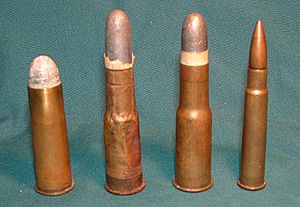
The original Martini–Henry rifles used a large bullet that was 0.452 inches (11.5 mm) wide. This bullet weighed 485 grains, which is about 31 grams. It was wrapped in paper and had a hollow base. The bullet was loaded into a special cartridge case. At first, these cases were made of thin brass foil. Later, stronger brass cases were used.
The cartridge case had a paper lining. This was important to stop the black powder (the explosive inside the bullet) from reacting with the brass. This bullet and cartridge combination is now known as the .577/450. It was a "bottle-neck" design, meaning the case was wider at the bottom and narrower at the top.
The rifle used 85 grains (about 5.5 grams) of black powder. This powder was known for causing a strong kick (recoil) when fired. After firing, the empty cartridge case was pushed out from the back when the lever was moved.
The rifle was 49 inches (1,245 mm) long, which is about 124 centimeters. Its steel barrel was 33.22 inches (844 mm) long (about 84 centimeters). The barrel had seven special grooves inside, called "rifling," which made the bullet spin and fly straight. The rifle itself weighed about 8 pounds 7 ounces (3.83 kg) (about 3.8 kilograms).
Soldiers could attach a bayonet to the rifle. A bayonet is a knife that fits on the end of the gun. The standard bayonet was a long spike. When the bayonet was attached, the rifle became 68 inches (1,727 mm) long (about 173 centimeters) and weighed more.
The Mark II Martini–Henry rifle was the most common version. It was used in the Anglo-Zulu War in 1879. This rifle could hit targets up to 1,800 yards (1,600 m) away. However, it was most accurate for hitting a person-sized target up to 400 yards (370 m) (about 365 meters). This was because the bullet started to slow down a lot after 300 yards.
In the late 1870s, the British military wanted to use the same type of ammunition for all its guns. The .577/.450 cartridge was not ideal for new machine guns. So, they started looking into new, smaller bullets. By 1886, a new rifle called the Enfield Martini .4-inch Pattern A was approved. It had some small improvements, like a safety catch.
However, before this change was finished, the army decided to switch to a completely different rifle: the Lee–Metford. This rifle used a smaller .303 calibre bullet and had a "bolt-action" and a "magazine," which meant it could fire many shots quickly. Because of this, the Enfield–Martinis were changed back to the .45 calibre. Some .303 calibre versions were also made, called the Martini–Metford and Martini–Enfield.
Martini–Henry in Wars
During its time, the Martini–Henry was used in many wars fought by the British Empire. A famous example is the Anglo-Zulu War in 1879. The rifle was used in the Battle of Isandlwana. It was also used by British soldiers at the battle of Rorke's Drift. At Rorke's Drift, 139 British soldiers successfully defended themselves against thousands of Zulu warriors. The Martini–Henry rifle was not fully taken out of service until 1904.
During the Zulu War, the rifle sometimes had problems. The thin brass cartridge cases would expand too much when fired. This made them stick or tear inside the rifle's chamber. This made it hard to open the breech (the part where the bullet is loaded) and reload the rifle. If the breech couldn't be opened, the rifle became useless.
After looking into this, the British Army found that the weak cartridge cases and dirt from the black powder were the main problems. To fix this, stronger brass cases were made. Later versions of the rifle (like the Mark IV) also had a longer loading lever. This made it easier to operate the mechanism even when it was dirty.
Later, new types of powder (smokeless nitro powders) and copper-jacketed bullets were used with these rifles. This made them much more accurate and reliable. Hunters in Africa found that the Martini–Henry, with these new bullets, was powerful enough to stop large animals like hippos from up to 80 yards away.
The Martini–Henry remained popular for shooting competitions in Britain until the early 1900s. Shooters used it for targets up to 1,000 yards away. However, by 1904, most target shooters preferred the newer .303 calibre rifles, which were more accurate.
In 1879, it was generally found that the Martini–Henry Mk2 was best for hitting a man-sized target up to 400 yards. Beyond that, the bullet slowed down too much. During battles like Rorke's Drift, soldiers were often told to "volley fire" (all shoot at once) only when the Zulus were within 400 yards.
The power of the .577/450 Martini–Henry bullet was similar to the American .45/70 Government round. Reports from doctors during the Anglo–Zulu War showed that at 200 yards, the rifle caused very serious wounds. The sights on the Martini Mk2 were marked up to 1,800 yards. This setting was only used for very long-range "volley firing." This was done to bother enemy artillery or large groups of cavalry before a main fight.
Nepal also made copies of the British Martini–Henry. These Nepalese rifles were similar to the British Mark II but had some small differences. They can be identified by their Nepalese markings. Another different version, called the Gahendra rifle, was made in Nepal. These rifles were mostly made by hand, so their quality varied a lot.
The Martini–Henry was used in World War I in a few ways. It was a "Reserve Arm," meaning it was kept for backup. Early in the war, it was also given to aircrew. They used it to shoot at enemy observation balloons with new "incendiary" (fire-starting) bullets. Martini–Henrys were also used by local troops in Africa and the Middle East during World War I.
Greener Shotguns
A special shotgun version of the Martini action was made by the Greener company. It was called the Greener Police Gun or Greener Prison Shotgun. This gun used a unique 14.5-gauge brass shell. This meant that if someone stole the gun, they couldn't use it with regular shotgun shells. It was used by prison guards and police in places like Egypt, India, and Australia. Over 60,000 were made until the 1960s.
The Mark I/14 version, made in 1918, had a full wooden stock. Later, the Mark III/14 Shotgun was designed to prevent criminals from using regular shells. It had a special firing pin and a unique cartridge design that stopped other shells from being loaded.
Greener also used the Martini action for a regular single-barrel shotgun called the GP ("General Purpose"). This gun fired standard 12-gauge ammunition. It was a popular gun for gamekeepers and hunters in Britain until the 1960s.
Greener Harpoon Gun
W. W. Greener also made a Greener-Martini Light Harpoon Gun. This gun was used for hunting whales and large fish like tuna. It fired a .38 blank cartridge to push the harpoon forward. It had a special hollow barrel and stock to hold the harpoon and make the gun lighter.
Other Martini–Henry Rifles
The Ottoman Empire (an old empire that included Turkey) wanted Martini–Henry rifles but couldn't buy them from the British. So, they bought similar rifles from the Providence Tool Company in the United States. These rifles were used effectively against the Russians in the Russo-Turkish War (1877–1878). Famous outlaws in the Ottoman Empire, like Hekimoğlu, were known for using these rifles. They were called Aynalı Martin in the Ottoman Empire.
Starting in 1879, Romania also decided to use Martini–Henry rifles. They ordered 130,000 rifles from a company called Steyr Arms. These rifles were also used by Romania in the First World War.
Many versions of the Martini design were also made for the Boer Republics (in South Africa). These were made in Belgium and by Westley Richards in England. During the Second Boer War, many Boers used the Martini–Henry rifle.
How the Martini Action Works
The main parts of the rifle's firing system are held in place by a metal bolt (A). The "breech" (the part that closes the back of the barrel) is closed by a block (B). This block turns on a pin (C). The back of the block is rounded to fit into the rifle's case (D). This design helps the rifle absorb the force of the shot.
Below the trigger guard, a lever (E) moves a pin (F). This pin connects to a part called the tumbler (G). The tumbler moves the block up or down, depending on how the lever is moved.
The top of the block (B) has a hollow part (I). This helps you put a cartridge into the firing chamber (J). To fire, the block moves up, and the firing pin (K) lines up with the cartridge. The firing pin has a spring around it. When the lever (E) is moved forward, the tumbler (G) pulls back the spring. This gets the rifle ready to fire.
After you fire, the rifle helps pull out the empty cartridge. An "extractor" part rotates on a pin (M). It has two arms (N) that grab the rim of the cartridge. When the block drops down, a bent arm (O) pushes the extractor arms. This pulls the empty cartridge case out a little, making it easier to remove by hand.
The Martini breech action was also used for other types of guns. The Greener company used it for their single-shot "EP" riot guns, which were still used in the 1970s. The Greener "GP" shotgun, also using the Martini action, was a popular hunting gun. The Martini action was also used by BSA and Parker Hale for their "Small Action Martini" target rifles, which were made until 1955.
Comparing Rifles of the 1880s
| Calibre | System | Country | Velocity | Height of trajectory | Ammunition | ||||||||
|---|---|---|---|---|---|---|---|---|---|---|---|---|---|
| Muzzle | 500 yd (460 m) | 1,000 yd (910 m) | 1,500 yd (1,400 m) | 2,000 yd (1,800 m) | 500 yd (460 m) | 1,000 yd (910 m) | 1,500 yd (1,400 m) | 2,000 yd (1,800 m) | Propellant | Bullet | |||
| .433 in (11.0 mm) | Werndl–Holub rifle | Austria-Hungary | 1,439 ft/s (439 m/s) | 854 ft/s (260 m/s) | 620 ft/s (190 m/s) | 449 ft/s (137 m/s) | 328 ft/s (100 m/s) | 8.252 ft (2.515 m) | 49.41 ft (15.06 m) | 162.6 ft (49.6 m) | 426.0 ft (129.8 m) | 77 gr (5.0 g) | 370 gr (24 g) |
| .45 in (11.43 mm) | Martini–Henry | United Kingdom | 1,315 ft/s (401 m/s) | 869 ft/s (265 m/s) | 664 ft/s (202 m/s) | 508 ft/s (155 m/s) | 389 ft/s (119 m/s) | 9.594 ft (2.924 m) | 47.90 ft (14.60 m) | 147.1 ft (44.8 m) | 357.85 ft (109.07 m) | 85 gr (5.5 g) | 480 gr (31 g) |
| .433 in (11.0 mm) | Fusil Gras mle 1874 | France | 1,489 ft/s (454 m/s) | 878 ft/s (268 m/s) | 643 ft/s (196 m/s) | 471 ft/s (144 m/s) | 348 ft/s (106 m/s) | 7.769 ft (2.368 m) | 46.6 ft (14.2 m) | 151.8 ft (46.3 m) | 389.9 ft (118.8 m) | 80 gr (5.2 g) | 386 gr (25.0 g) |
| .433 in (11.0 mm) | Mauser Model 1871 | Germany | 1,430 ft/s (440 m/s) | 859 ft/s (262 m/s) | 629 ft/s (192 m/s) | 459 ft/s (140 m/s) | 388 ft/s (118 m/s) | 8.249 ft (2.514 m) | 48.68 ft (14.84 m) | 159.2 ft (48.5 m) | 411.1 ft (125.3 m) | 75 gr (4.9 g) | 380 gr (25 g) |
| .408 in (10.4 mm) | M1870 Italian Vetterli | Italy | 1,430 ft/s (440 m/s) | 835 ft/s (255 m/s) | 595 ft/s (181 m/s) | 422 ft/s (129 m/s) | 304 ft/s (93 m/s) | 8.527 ft (2.599 m) | 52.17 ft (15.90 m) | 176.3 ft (53.7 m) | 469.9 ft (143.2 m) | 62 gr (4.0 g) | 310 gr (20 g) |
| .397 in (10.08 mm) | Jarmann M1884 | Norway and Sweden | 1,536 ft/s (468 m/s) | 908 ft/s (277 m/s) | 675 ft/s (206 m/s) | 504 ft/s (154 m/s) | 377 ft/s (115 m/s) | 7.235 ft (2.205 m) | 42.97 ft (13.10 m) | 137.6 ft (41.9 m) | 348.5 ft (106.2 m) | 77 gr (5.0 g) | 337 gr (21.8 g) |
| .42 in (10.67 mm) | Berdan rifle | Russia | 1,444 ft/s (440 m/s) | 873 ft/s (266 m/s) | 645 ft/s (197 m/s) | 476 ft/s (145 m/s) | 353 ft/s (108 m/s) | 7.995 ft (2.437 m) | 47.01 ft (14.33 m) | 151.7 ft (46.2 m) | 388.7 ft (118.5 m) | 77 gr (5.0 g) | 370 gr (24 g) |
| .45 in (11.43 mm) | Springfield model 1884 | United States | 1,301 ft/s (397 m/s) | 875 ft/s (267 m/s) | 676 ft/s (206 m/s) | 523 ft/s (159 m/s) | 404 ft/s (123 m/s) | 8.574 ft (2.613 m) | 46.88 ft (14.29 m) | 142.3 ft (43.4 m) | 343.0 ft (104.5 m) | 70 gr (4.5 g) | 500 gr (32 g) |
| .40 in (10.16 mm) | Enfield-Martini | United Kingdom | 1,570 ft/s (480 m/s) | 947 ft/s (289 m/s) | 719 ft/s (219 m/s) | 553 ft/s (169 m/s) | 424 ft/s (129 m/s) | 6.704 ft (2.043 m) | 39.00 ft (11.89 m) | 122.0 ft (37.2 m) | 298.47 ft (90.97 m) | 85 gr (5.5 g) | 384 gr (24.9 g) |
Users of the Martini–Henry
- Afghanistan
- Argentina
- Bolivia
- British Empire
- Chile
- Ethiopian Empire
- Kingdom of Greece
- Provisional Irish Republican Army
- Ottoman Empire
- Peru
- Kingdom of Romania
- Siam
- Ulster Volunteers
See Also
- British military rifles
- Swinburn–Henry
- Martini–Enfield – the .303 calibre version of the Martini–Henry
- Martini Cadet – Cadet target shooting rifle


